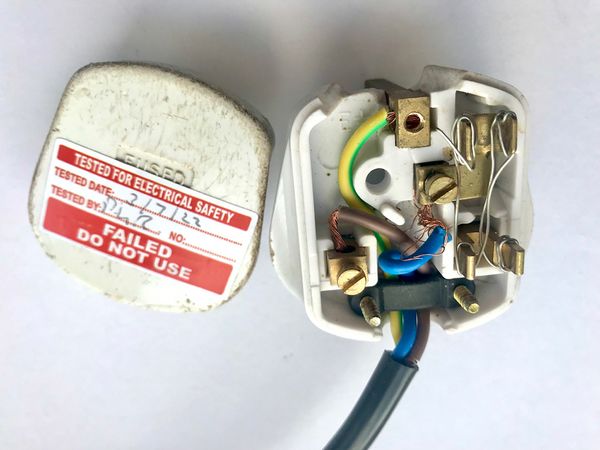How NOT to wire a (UK) mains plug: Difference between revisions
No edit summary |
|||
| Line 29: | Line 29: | ||
<div class="mw-collapsible-content"> | <div class="mw-collapsible-content"> | ||
The live (brown) and blue (neutral) wires are the wrong way round. The brown '''must''' go to the screw terminal next to the fuse and the blue to the screw terminal opposite. | The live (brown) and blue (neutral) wires are the wrong way round. The brown '''must''' go to the screw terminal next to the fuse and the blue to the screw terminal opposite. | ||
</div></div> | |||
<div class="toccolours mw-collapsible mw-collapsed"> | |||
<div>'''Fault 4:'''</div> | |||
<div class="mw-collapsible-content"> | |||
There is no screw in the earth screw terminal (with the green/yellow wire). All screws '''must''' be tight, otherwise the pug may overheat. In addition, the lack of a proper earth connection could be highly dangerous. | |||
</div></div> | </div></div> | ||
| Line 34: | Line 40: | ||
<div>'''Fault 5:'''</div> | <div>'''Fault 5:'''</div> | ||
<div class="mw-collapsible-content"> | <div class="mw-collapsible-content"> | ||
The insulation on brown wire has been stripped back too far, leaving exposed copper. | |||
</div></div> | </div></div> | ||
| Line 40: | Line 46: | ||
<div>'''Fault 6:'''</div> | <div>'''Fault 6:'''</div> | ||
<div class="mw-collapsible-content"> | <div class="mw-collapsible-content"> | ||
The | The blue wire has loose whiskers of wire which could cause a short circuit. | ||
</div></div> | </div></div> | ||
| Line 46: | Line 52: | ||
<div>'''Fault 7:'''</div> | <div>'''Fault 7:'''</div> | ||
<div class="mw-collapsible-content"> | <div class="mw-collapsible-content"> | ||
The blue | The cable clamp is clamping the inner wires, causing strain on the insulation. The outer sheath of the cable '''must''' be firmly clamped to prevent any strain on the connections or the inner (brown, blue and green/yellow) wires. | ||
</div></div> | </div></div> | ||
| Line 52: | Line 58: | ||
<div>'''Fault 8:'''</div> | <div>'''Fault 8:'''</div> | ||
<div class="mw-collapsible-content"> | <div class="mw-collapsible-content"> | ||
Look carefully: the brown wire has been nicked in cutting the outer sheath. The copper of the live wire is exposed. | |||
</div></div> | </div></div> | ||
[[Category:General]] | [[Category:General]] | ||
Revision as of 20:57, 26 October 2022
This page illustrates a number of different faults in wiring a mains plug, all of them potentially dangerous.
Summary
Wiring a mains plug is not hard, and most of the pitfalls are easy to recognise.
Safety
- A badly or incorrectly wired mains plug can create a risk of electric shock or fire.
How NOT to do it!
See how many faults you can spot before revealing the answers by clicking the down-arrows on the right.
The plastic shell of the plug is broken. There must be no physical damage or signs of overheating.
There is a piece of wire in place of the fuse. The plug must contain a suitably rated fuse, otherwise in the event of a fault, a dangerously large current may flow before one of the house fuses blows.
The live (brown) and blue (neutral) wires are the wrong way round. The brown must go to the screw terminal next to the fuse and the blue to the screw terminal opposite.
There is no screw in the earth screw terminal (with the green/yellow wire). All screws must be tight, otherwise the pug may overheat. In addition, the lack of a proper earth connection could be highly dangerous.
The insulation on brown wire has been stripped back too far, leaving exposed copper.
The blue wire has loose whiskers of wire which could cause a short circuit.
The cable clamp is clamping the inner wires, causing strain on the insulation. The outer sheath of the cable must be firmly clamped to prevent any strain on the connections or the inner (brown, blue and green/yellow) wires.
Look carefully: the brown wire has been nicked in cutting the outer sheath. The copper of the live wire is exposed.
